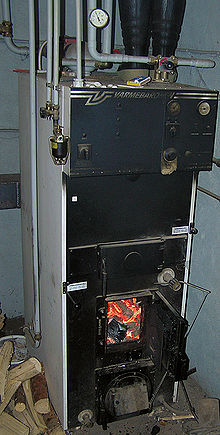– دیگهای آب گرم حرارت مرکزی غیراز آنهایی که مشمول شماره 8402 می باشند در شماره تعرفه 8403 طبقه بندی می شوند.
Central heating boilers other than those of heading 84.02.
شوفاژ یا حرارت مرکزی سیستمی است برای تولید گرما در منازل و ساختمانها. در این سیستم گرمای منزل در یک محل تولید شده و توسط رادیاتورها و لولهها به دیگر نقاط ساختمان منتقل میشود
شوفاژخانه محلی است که در آن آب گرم میشود و به رادیاتورها میآید ودر داخل شوفاژ جریان پیدا میکند ورادیاتور را گرم میکند البته وقتی که پیچ روشن و خاموش کردن رابازکنیم این اتفاق رخ میدهد .
این توضیح مختصری دربارهٔ شوفاژ بود. در شوفاژ خانه موتوری بزرگی وجود دارد که برروی آن آمپری وجود دارد که درجه حرارت را نشان میدهد و یک دکمهای وجود که درجه حرارت را تنظیم می کند. در موتور شوفاژ خانه گرمایی ایجادمی شود که وقتی آب تانکر وارد این موتور میشود موتور آن را گرم کرده و به درجهٔ مشخص شده می رساند .
گرمای این موتور از مشعل گرفته میشود و شمعک این مشعل همیشه روشن است .
این آبهایی که گرم شده به وسیله موتور پمپ بالامیرود و به هرطبقه میرسد .این موتور پمپها دکمه مشخصی دارد که آبرا با چه سرعت و تا کجا بالا ببرد . هر طبقه لولههای مشخصی برای رفت وبرگشت آب دارد و سر هر لوله پیچی برای بازو بسته کردن وجود دارد که میتوان با آن این لولهها را بست و را ه ورود آب به شوفاژ را گرفت . وقتی که آب داخل تانکر تمام شود از لولههای آب این آب دوباره برگردانده میشود ونیز یک کنتور هم وجود دارد که برق موتور را تامین میکند .
A central heating system provides warmth to the whole interior of a building (or portion of a building) from one point to multiple rooms. When combined with other systems in order to control the building climate, the whole system may be an HVAC (heating, ventilation andair conditioning) system.
Central heating differs from local heating in that the heat generation occurs in one place, such as a furnace room in a house or amechanical room in a large building (though not necessarily at the “central” geometric point). The most common method of heat generation involves the combustion of fossil fuel in a furnace or boiler. The resultant heat then gets distributed: typically by forced-airthrough ductwork, by water circulating through pipes, or by steam fed through pipes. Increasingly, buildings utilize solar-powered heat sources, in which case the  distribution system normally uses water circulation.
distribution system normally uses water circulation.
In much of the temperate climate zone, most new housing has come with central heating installed since the Second World War, at least. Such areas normally use gas heaters, district heating, or oil-fired system, often using forced-air systems. Steam-heating systems, fired by coal, oil or gas, are also used, primarily for larger buildings. Electrical heating systems occur less commonly and are practical only with low-cost electricity or when ground source heat pumps are used. Considering the combined system of central generating plant and electric resistance heating, the overall efficiency will be less than for direct use of fossil fuel for space heating
Common components of a central heating system using water-circulation include:
- Gas supply lines (sometimes including a propane tank), oil tank and supply lines or district heating supply lines
- Boiler (or a heat exchanger for district heating): heats water in a closed-water system
- Pump: circulates the water in the closed system
- Radiators: wall-mounted panels through which the heated water passes in order to release heat into rooms
Engineers in the United Kingdom and in other parts of Europe commonly combine the needs of room heating with hot-water heating and storage. These systems occur less commonly in the USA. In this case, the heated water in a sealed system flows through a heat exchanger in a hot-water tank or hot-water cylinder where it heats water from the normal water supply before that water gets fed to hot-water outlets in the house. These outlets may service hot-water taps or appliances such as washing machines or dishwashers.

Expansion tank
[edit]Sealed water-circulating system
A sealed system provides a form of central heating in which the water used for heating usually circulates independently of the building’s normal water supply. An expansion tank contains compressed gas, separated from the sealed-system water by a diaphragm. This allows for normal variations of pressure in the system. A safety valve allows water to escape from the system when pressure becomes too high, and a valve can open to replenish water from the normal water supply if the pressure drops too low. Sealed systems offer an alternative to open-vent systems, in which steam can escape from the system, and gets replaced from the building’s water supply via a feed and central storage system.